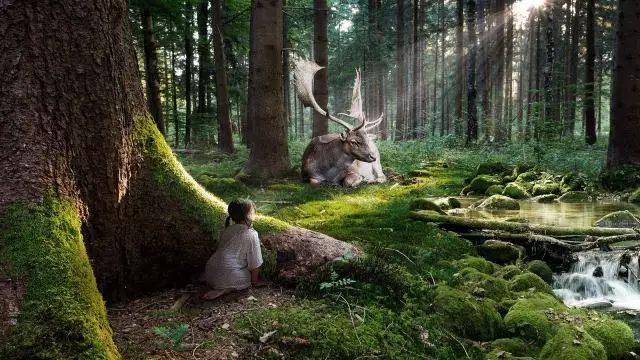1. Imagine you're walking through a forest. I'm guessing you're thinking of a collection of trees. Yes, trees are the foundation of forests, but a forest is much more than what you see, and today I want to change the way you think about forests. You see, underground there is this other world, a world of infinite biological pathways that connect trees and allow them to communicate and allow the forest to behave as though it's a single organism. It might remind you of a sort of intelligence.
想象你正穿行在森林中。我猜你想的是一大片树,是的,树是森林的基础,但是森林可比你看到的复杂多了,而今天我想改变一下你们对森林的看法。你知道吗,森林的地下是另外一个世界,一个拥有无限的生物通路的世界,这些通路把树木连接起来,使得它们可以彼此沟通,也使森林表现得好像一个单独的有机体。这可能会让你想到某种程度的智慧。
Trees in real forests might also share information below ground. It turns out at that time of the year, in the summer, that birch was sending more carbon to fir than fir was sending back to birch, especially when the fir was shaded. And then in later experiments, we found the opposite, that fir was sending more carbon to birch than birch was sending to fir, and this was because the fir was still growing while the birch was leafless.
在真正的森林中,树木可能还会在地下交流信息。结果还表明在每年的这个时间,在夏天的时候,纸皮桦给花旗松送的碳比花旗松反送给它的要多,特别是当花旗松见不到阳光的时候。而在随后的实验中,我们发现了相反的情况,花旗松给纸皮桦送的碳比纸皮桦给它的碳多,这是因为当纸皮桦树叶掉光了的时候花旗松还在不停的生长。
So it turns out the two species were interdependent, like yin and yang. I knew I had found something big, something that would change the way we look at how trees interact in forests, from not just competitors but to cooperators.
这就说明这两种树其实是相互依赖的,就像“阴”和“阳”。在那个时候,事情开始变得清晰起来。我知道我有了重大发现,这个发现可以改变我们对森林中树木互动方式的看法,树木之间不仅有竞争关系,同时也有合作关系。

2. How were paper birch and Douglas fir communicating? Well, it turns out they were conversing not only in the language of carbon but also information. The web is so dense that there can be hundreds of kilometers of mycelium under a single footstep. And not only that, that mycelium connects different individuals in the forest, and it works kind of like the Internet.
纸皮桦和花旗松到底是怎么交流的呢?实际上,它们不仅仅使用碳元素作为它们交流的语言,其实还有氮元素和磷元素,这个网络无比密集以至于在你每走过一步脚下的菌丝连起来可以有几百公里长。不仅如此,菌丝跟森林中其它的个体也都有联系,这种联系不仅仅在单一的种类中存在,在不同种类之间也存在,比如纸皮桦和花旗松,而且它的工作原理就像是互联网一样。
You see, like all networks, mycorrhizal networks have nodes and links. The biggest, darkest nodes are the busiest nodes. We call those hub trees, or more fondly, mother trees, because it turns out that those hub trees nurture their young, the ones growing in the understory. In a single forest, a mother tree can be connected to hundreds of other trees.
你们看,就像所有的网络一样,真菌的网络中也有节点和链接。那些最大的、颜色最深的节点就是最繁忙的、连接最多的节点。我们把它们称作中心树,或者更亲切地称之为母树。因为事实证明,这些中心树哺育着它们的小树,那些小树都处在林下叶层。在一片森林中,一棵母树可以和其它几百棵树建立联系。
Mother trees colonize their kin with bigger mycorrhizal networks. They send them more carbon below ground. They even reduce their own root competition to make elbow room for their kids. When mother trees are injured or dying, they also send messages of wisdom on to the next generation of seedlings. So trees talk. Through back and forth conversations, they increase the resilience of the whole community.
母树通过更大的菌根网络来覆盖住自己孩子们所在的区域。在地下,它们给孩子们会送去更多的碳。它们甚至会减少它们自己和其它树根部的竞争,来为它们的孩子们创造更多的活动空间。当母树受伤或即将枯死的时候,它们还会把智慧信息传给下一代的幼苗。所以树是会说话的。通过反反复复的对话,它们增强了整个团体的恢复力。
3. So let's come back to the initial point. Forests aren't simply collections of trees, they're complex systems with hubs and networks that overlap and connect trees and allow them to communicate, and they provide avenues for feedbacks and adaptation, and this makes the forest resilient. You see, you can take out one or two hub trees, but there comes a tipping point, because hub trees are not unlike rivets in an airplane. You can take out one or two and the plane still flies, but you take out one too many, or maybe that one holding on the wings, and the whole system collapses.
那么让我们回到最初的话题吧。森林不是简简单单的树的“集合”,森林是拥有枢纽和网络的复杂系统,它可以承载树木并且把树连接起来,使得它们可以互相沟通,它给树木提供了互相反馈的渠道和适应的方式,也使得森林的恢复力变得更强。你们看,我们可以拿走一两颗中心树,但这样就会达到森林承受极限了,因为森林里的中心树就像是飞机里的铆钉。你卸下一两个铆钉的话飞机还能飞,但是如果你一次卸下太多,或是仅仅卸下固定机翼的那一颗铆钉,整个系统就要崩溃了。
So I want to come back to my final question: instead of weakening our forests, how can we reinforce them and help them deal with climate change? First, we all need to get out in the forest. We need to reestablish local involvement in our own forests. Second, we need to save our old-growth forests. These are the repositories of genes and mother trees and mycorrhizal networks. And third, when we do cut, we need to save the legacies, the mother trees and networks, and the wood, the genes, so they can pass their wisdom onto the next generation of trees so they can withstand the future stresses coming down the road. And finally, we have to give Mother Nature the tools she needs to use her intelligence to self-heal.
所以现在我想提我的最后一个问题:与破坏我们的森林相反,我们怎么才能让它们变得更强大,怎么才能帮助它们应对气候变化呢?首先,我们都得走出家门,走进森林。我们需要重新使当地的居民融入到我们森林中去。第二,我们需要保护好我们的古老森林。保护好它们就是保护好了森林的基因库、保护好了母树和菌根网络。第三,当我们伐木时,我们需要保护森林的“遗产”——母树和菌根网络,还有树干和基因,这样它们就能把它们的智慧传给下一代的树木,这样整个森林就能禁得起未来将会面对的重重困难了。最后,第四点,我们需要给大自然母亲她需要的工具,好让她用自己的智慧来进行自愈。












